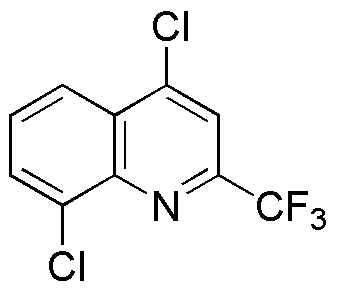4,8-Dichloro-2-(trifluoromethyl)quinoline is widely utilized in research focused on:
- Pharmaceutical Development: This compound serves as a key intermediate in the synthesis of various pharmaceuticals, particularly in developing anti-infective agents and anti-cancer drugs, enhancing therapeutic options.
- Agricultural Chemicals: It is used in formulating agrochemicals, including herbicides and fungicides, providing effective solutions for pest control while minimizing environmental impact.
- Material Science: The compound is explored for its potential in creating advanced materials, such as polymers and coatings, which exhibit enhanced durability and resistance to degradation.
- Analytical Chemistry: It acts as a reference standard in analytical labs for the detection and quantification of related compounds, ensuring accuracy in research and quality control processes.
- Biochemical Research: Researchers utilize this compound to study its interaction with biological systems, aiding in the understanding of disease mechanisms and the development of targeted therapies.
Informations générales
Propriétés
Sécurité et réglementation
Applications
4,8-Dichloro-2-(trifluoromethyl)quinoline is widely utilized in research focused on:
- Pharmaceutical Development: This compound serves as a key intermediate in the synthesis of various pharmaceuticals, particularly in developing anti-infective agents and anti-cancer drugs, enhancing therapeutic options.
- Agricultural Chemicals: It is used in formulating agrochemicals, including herbicides and fungicides, providing effective solutions for pest control while minimizing environmental impact.
- Material Science: The compound is explored for its potential in creating advanced materials, such as polymers and coatings, which exhibit enhanced durability and resistance to degradation.
- Analytical Chemistry: It acts as a reference standard in analytical labs for the detection and quantification of related compounds, ensuring accuracy in research and quality control processes.
- Biochemical Research: Researchers utilize this compound to study its interaction with biological systems, aiding in the understanding of disease mechanisms and the development of targeted therapies.
Documents
Fiches de données de sécurité (FDS)
La FDS fournit des informations de sécurité complètes sur la manipulation, le stockage et l’élimination du produit.
Spécifications du produit (PS)
Le PS fournit une description complète des propriétés du produit, notamment sa composition chimique, son état physique, sa pureté et les exigences de stockage. Il détaille également les plages de qualité acceptables et les applications prévues du produit.
Certificats d'analyse (COA)
Recherchez des certificats d'analyse (COA) en saisissant le numéro de lot du produit. Les numéros de lot et de lot se trouvent sur l'étiquette d'un produit, après les mots « Lot » ou « Lot de fabrication ».
Numéro de catalogue
Numéro de lot/série
Certificats d'origine (COO)
Ce certificat d'exploitation confirme le pays dans lequel le produit a été fabriqué, et détaille également les matériaux et composants utilisés et s'il est issu de sources naturelles, synthétiques ou autres sources spécifiques. Ce certificat peut être requis pour les douanes, le commerce et la conformité réglementaire.
Numéro de catalogue
Numéro de lot/série
Fiches de données de sécurité (FDS)
La FDS fournit des informations de sécurité complètes sur la manipulation, le stockage et l’élimination du produit.
DownloadSpécifications du produit (PS)
Le PS fournit une description complète des propriétés du produit, notamment sa composition chimique, son état physique, sa pureté et les exigences de stockage. Il détaille également les plages de qualité acceptables et les applications prévues du produit.
DownloadCertificats d'analyse (COA)
Recherchez des certificats d'analyse (COA) en saisissant le numéro de lot du produit. Les numéros de lot et de lot se trouvent sur l'étiquette d'un produit, après les mots « Lot » ou « Lot de fabrication ».
Numéro de catalogue
Numéro de lot/série
Certificats d'origine (COO)
Ce certificat d'exploitation confirme le pays dans lequel le produit a été fabriqué, et détaille également les matériaux et composants utilisés et s'il est issu de sources naturelles, synthétiques ou autres sources spécifiques. Ce certificat peut être requis pour les douanes, le commerce et la conformité réglementaire.


